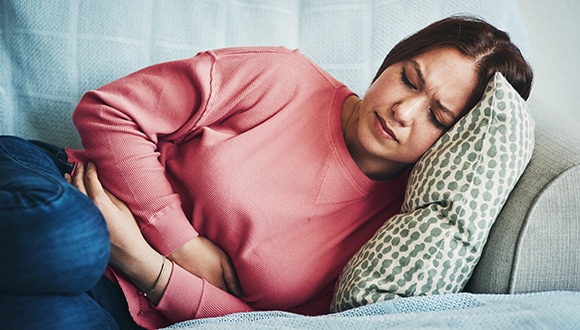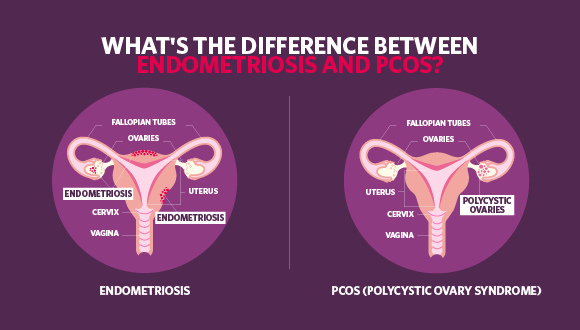Endometriosis vs PCOS: what’s the difference?
Published February 2023 | 3 min read
Words by Caitlin Wright
The symptoms of endometriosis and polycystic ovary syndrome (PCOS) often overlap – both can impact your period and fertility. But they’re two very distinct conditions.
Endometriosis and polycystic ovary syndrome are both conditions that can be painful, affect a woman’s menstrual cycle and fertility, and impact on her general wellbeing. They share some similar symptoms, but these conditions differ from each other – and it's possible to have both, which can make diagnosis complicated.
A study found women diagnosed with PCOS were more likely to be diagnosed with endometriosis. And a 2021 review of research on both conditions suggests that endometriosis occurs in 7 to 8% of females with PCOS and is usually mild.

What is endometriosis?
Endometriosis is a chronic inflammatory condition where cells similar to those that line the uterus grow in other parts of your body – most commonly in the pelvis. Instead of leaving your body during menstruation, they bleed, causing pain and inflammation. These cells
heal, creating scar tissue and ‘adhesions’ between the uterus, ovaries, fallopian tubes and bowel, which can be painful, and affect fertility.
What is PCOS?
PCOS is a complex hormonal condition that affects the ovaries.
The main features are:
- ovaries don’t regularly release eggs (ovulation)
- there can be high levels of male hormones known as androgens
- the ovaries are often polycystic, which is when they’re enlarged and contain fluid-filled sacs.
You may be diagnosed with PCOS if you have at least two of these features.
How common is endometriosis vs PCOS?
They’re both quite common. Endometriosis affects about one in nine women and PCOS affects about one in 10 of women.
It’s also common to be unaware that you have it. There's a seven to 12 year delay from symptom onset to diagnosis of endometriosis. It’s suspected up to 75% of women with PCOS are undiagnosed when visiting their doctor.
What are some common symptoms of endometriosis?
Pain is a key symptom – before and during a period, during or after sex, or when going to the toilet. While many women are told that period pain is normal, according to Jean Hailes period pain is only considered 'normal' if:
- the pain is there only on the first one or two days of your period
- the pain goes away if you take period pain medications or use the contraceptive pill
- your ability to do your normal activities is not impaired.
Heavy or irregular menstrual bleeding, bladder and bowel problems, bloating and tiredness are also common.
What are the common symptoms of PCOS?
Women can have mild or severe PCOS symptoms, including irregular or painful periods, excess facial or body hair, acne, weight gain and mood changes.
For both conditions, symptoms include heavy, irregular and painful periods however, each condition has specific symptoms too, which don’t overlap.

What causes endometriosis?
Family history and backwards or ‘retrograde’ menstruation – where blood flows into the pelvis as well as out of the vagina – are thought to play a role, but the exact cause is unknown.
What causes PCOS?
Family history, an imbalance of insulin and androgens, insulin resistance – when your body stops responding normally to insulin – and being overweight are risk factors, but experts aren’t sure.
How does endometriosis affect fertility?
Scarring of the fallopian tubes and ovaries, problems with egg quality and issues with embryo implantation can affect fertility, but most women will become pregnant without any medical assistance.
How does PCOS affect fertility?
High levels of androgens and insulin can affect ovulation. About 70% of women experience difficulties becoming pregnant, but research shows women with PCOS have the same number of children as women without the condition.
How is endometriosis diagnosed?
Currently, the only way to diagnose endometriosis is by having laparoscopic surgery (keyhole surgery), although research is currently underway to determine new methods of diagnosis. Endometriosis is usually classified in stages from minimal to severe.
How is PCOS diagnosed?
Depending on your symptoms, to be diagnosed with PCOS you may need to have a blood test and/or an ultrasound.
How to treat endometriosis
Healthy lifestyle habits, pain-relief medications and hormone therapies like the contraceptive pill can help. Surgery may also be an option. Speak to your GP about treatment options.
How to treat PCOS
A healthy lifestyle is the most effective approach. If you’re overweight, losing 5 to 10% of your body weight can have an impact. Your doctor may also recommend hormone or insulin treatments.
For both conditions, it’s important to talk to your GP about treatment options.
An in-person visit is always best but if you can't get to the GP practice, our partnership with GP2U, an online video GP service, makes it easier for you to access telehealth services. Speak to a GP from the convenience of your own home – GP2U doctors can issue prescriptions, referrals to specialists and provide medical certificates just like visiting a GP in a practice.
Through our partnership with GP2U, all HCF members with health cover can access a standard online video GP consultation (up to 10 minutes) for a fee of $50. See hcf.com.au/gp2u for more information.
RELATED ARTICLES
Getting pregnant with endometriosis
Many women with endometriosis are able to conceive, and help is on hand for those navigating endometriosis and fertility.
What is endometriosis?
Endometriosis is one of the most common gynaecological causes of chronic pelvic pain, affecting one in nine Australian women by age 44.
Endometriosis diagnosis
An endometriosis diagnosis can take years. But new research and awareness are giving hope to Aussie women living with the condition.
Endometriosis surgery: what you need to know
If you need surgery for endometriosis – here’s how to prepare and what to expect.